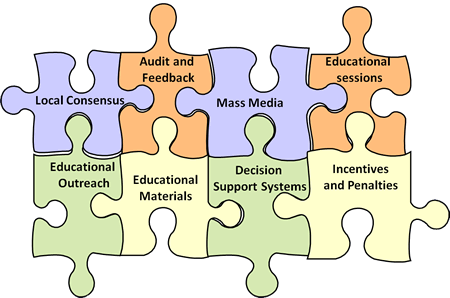A summary of the strategies that assist change
Strategies for change often work best in combination, using an integrated long- and short-term approach.

| Local consensus processes | These involve local health professionals in solving local problems. Using clinical ‘opinion leaders’ helps to disseminate information and maintain enthusiasm. |
|---|---|
| Audit and feedback | These are continuing processes in which clinical performance over a set period is summarised and data reported to the clinicians. Audits should be short and targeted, easy to complete and compile. Feedback is a very important part of the process as it helps to maintain motivation. |
| Mass media campaigns | Mass media campaigns can be successful, and are especially useful for advertising in a local newspaper where the target audience is more easily identified. Information can be given by contacting a journalist, talkback radio, letters to the editor, etc. |
| Educational sessions | Lectures, personal visits, or workshop sessions can help to increase knowledge, are cheap and easy to set up. |
| Educational outreach visits | Face to face education by trained personnel to clinicians in their practice settings. This strategy is often used when a new treatment process is introduced. |
| Educational material | Educational materials can include materials such as audio-visual materials, electronic publications, and journal articles. |
| Decision support systems | Decision-support systems include manual and automated initiatives that prompt health professionals to perform a clinical action, e.g., computer generated screening reminders, stickers on charts, etc. |
| Incentives and penalties | Personal satisfaction, improved patient outcomes or experience, promotion, CPD points, and local recognition can all act as incentives. Extra workloads, limited time, and the need for extra resources will act as disincentives. Try to find the `what’s in it for me’ for your change group. |
Read more from the Clinical Excellence Commission about the active dissemination of best practice and ensuring that gains are maintained beyond the life of a project. [12]
